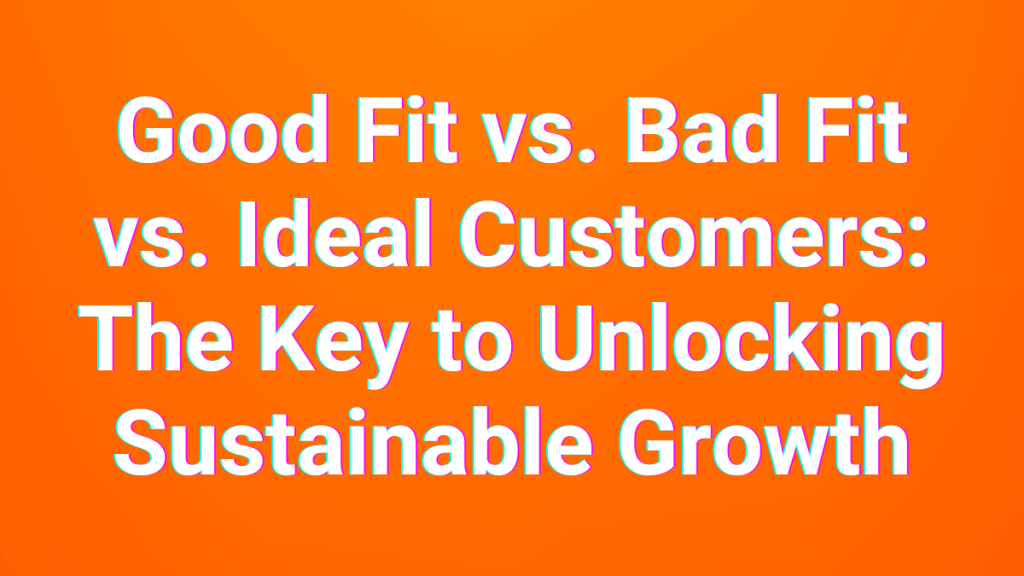
Maybe you need to not acquire those customers.
I know—that might sound counterintuitive in a world where we’re often told that more customers equal more success. But the reality is, chasing every potential customer can be a costly mistake that hinders your growth, drains your resources, and even damages your brand reputation.
Think about it: Have you ever onboarded a customer who seemed more trouble than they were worth? Maybe they constantly demanded features you didn’t offer, required excessive support, or churned quickly, leaving negative feedback in their wake. These are the bad fit customers, and they can do more harm than good.
Understanding the difference between good fit and bad fit customers isn’t just a nice-to-have—it’s critical for driving customer success and sustainable growth. It’s about being intentional with who you serve, ensuring that every customer has the potential to succeed with your product or service.
Let’s break down the distinctions between bad fit customers, good fit customers, and your Ideal Customer Profile (ICP), and explore how this clarity can transform your business.
Bad Fit Customers: When Saying “No” Is the Best Option
Let’s start with the worst-case scenario: bad fit customers.
Bad fit customers lack success potential with your product or service. Simply put, they can’t achieve their desired outcomes using what you offer. Maybe you don’t have the functionality they need, or perhaps you can’t provide the appropriate support or experience they require.
Bringing on bad fit customers is a lose-lose situation:
- They won’t derive value from your product.
- They’ll likely churn before you can recoup the cost of acquiring them.
- They might leave negative reviews, deterring other potential customers.
So how do you identify bad fit customers before it’s too late?
Create a Success Potential Checklist
Evaluate potential customers based on these six critical fits:
- Technical Fit: Do we have the technical capabilities they need?
- Functional Fit: Does our product fulfill their functional requirements?
- Competence Fit: Do they have the necessary skills to use our product effectively?
- Experience Fit: Have they used similar products before?
- Cultural Fit: Are our cultures compatible?
- Resource Fit: Do they have the resources (time, money, personnel) to succeed with our product?
If a potential customer doesn’t meet these criteria, it’s a red flag. Politely steering them away can save both parties time, money, and frustration.
Good Fit Customers: The Middle Ground
Next up are the good fit customers.
Good fit customers meet your success potential criteria—they have the potential to succeed with your product—but success isn’t guaranteed. This is where your Customer Success Management efforts come into play to unlock that potential.
While it’s great to have good fit customers, consider this:
- Don’t actively pursue them: Resources are finite, and investing heavily in acquiring customers who are merely a good fit might not yield the best return on investment.
- Serve them well if they come to you: Provide excellent service, but focus your proactive efforts elsewhere.
Good fit customers will benefit from your product, but they might not have the highest lifetime value or become your biggest advocates.
Ideal Customer Profile (ICP): The Gold Standard
Finally, let’s talk about your Ideal Customer Profile (ICP).
Your ICP represents customers who are not only a good fit but who, once their potential is unlocked:
- Stay longer
- Buy more
- Advocate for your brand
These customers offer the highest lifetime value and contribute significantly to your sustainable growth.
Defining Your ICP
Consider the following when identifying your ICP:
- Readiness: They recognize the problem your product solves and are ready to take action.
- Willingness: They’re prepared to invest time, money, and effort to achieve their goals.
- Ability: They have the necessary resources and authority to make decisions and implement your solution.
- Acquisition Efficiency: The cost of acquiring them is justified by their potential lifetime value.
- Ascension Potential: There’s room for upselling or cross-selling additional products or services.
- Advocacy Potential: They’re likely to become promoters of your brand, referring others and providing testimonials.
By focusing your acquisition efforts on your ICP, you’re investing resources where they’ll have the greatest impact.
Why Your ICP Matters
Having a clear definition of your Ideal Customer is one of the most important things you can do for your business:
- Product Development: Tailor features and functionality to meet the needs of your ICP.
- Marketing and Messaging: Use language and emotion that resonates with them.
- Resource Allocation: Invest in channels and strategies that effectively reach them.
Remember, you get to choose your customers. If you don’t proactively decide who you want to do business with, your customers will choose you—and they might not be the ones who can succeed with your product.
The Power of Choice: Aligning Efforts for Maximum Impact
Understanding these distinctions allows you to:
- Avoid Bad Fit Customers: Politely decline and, if possible, guide them toward a better solution.
- Welcome Good Fit Customers: Serve them effectively if they come your way but allocate minimal acquisition resources.
- Focus on Your ICP: Invest in marketing, sales, and customer success efforts that target and serve your ideal customers.
This strategic approach ensures that your efforts and investments yield the best possible returns.
Conclusion: Choosing Wisely for Sustainable Growth
Identifying and focusing on your ideal customers isn’t about being exclusive—it’s about being smart.
- Reduce Churn: Serving customers who can succeed reduces the likelihood they’ll leave.
- Enhance Reputation: Satisfied customers become advocates, enhancing your brand.
- Drive Growth: Ideal customers contribute more revenue over time through renewals, upgrades, and referrals.
So take the time to define your ICP. Be clear about who you’re targeting and why. Align your product development, marketing, and customer success strategies around serving these customers exceptionally well.
Not all customers are created equal—and that’s a good thing. By choosing your customers wisely, you’re setting the stage for sustainable growth and long-term success.
